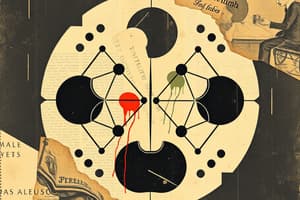Podcast
Questions and Answers
What is the primary outcome of the mitotic phase in somatic cell division?
What is the primary outcome of the mitotic phase in somatic cell division?
- Centrosome duplication occurs.
- Two genetically identical cells are formed. (correct)
- The replication of DNA is completed.
- Cells enter a prolonged G0 phase.
During which phase of the cell cycle is DNA replication taking place?
During which phase of the cell cycle is DNA replication taking place?
- S phase (correct)
- M phase
- G1 phase
- G2 phase
What initiates cytokinesis during somatic cell division?
What initiates cytokinesis during somatic cell division?
- Alignment of chromosomes at the equatorial plane.
- Initiation of the S phase.
- Formation of the contractile ring. (correct)
- Replication of centrosomes.
Which of the following describes the G0 phase in the cell cycle?
Which of the following describes the G0 phase in the cell cycle?
Which process is NOT a part of mitosis?
Which process is NOT a part of mitosis?
What process begins during early prophase to prevent the entangling of DNA strands?
What process begins during early prophase to prevent the entangling of DNA strands?
What is the main event that occurs during metaphase?
What is the main event that occurs during metaphase?
Which of the following accurately describes the movement of chromatids during anaphase?
Which of the following accurately describes the movement of chromatids during anaphase?
What structural change occurs to the nuclear envelope by the end of telophase?
What structural change occurs to the nuclear envelope by the end of telophase?
What critical change happens to the mitotic spindle during telophase?
What critical change happens to the mitotic spindle during telophase?
Flashcards are hidden until you start studying
Study Notes
Cell Division
- Cell division is the process of cells reproducing themselves
- Reproductive cell division is called meiosis, and reduces the number of chromosomes in half
- Germ cells are gametes (sperm or oocyte) or predecessor cells destined to become gametes
- Gametes are cells needed to form the next generation of sexually reproducing organisms
- Somatic cell division involves mitosis and cytokinesis
- Mitosis is nuclear division, cytokinesis is cytoplasmic division
- Somatic cell division results in two genetically identical cells
Cell Cycle
- The cell cycle consists of:
- Interphase: When the cell is not dividing
- Mitotic phase (M phase): When the cell is dividing
- Interphase has three subphases:
- G1 phase: Interval between mitotic phase and S phase, takes 8-10 hours. The cell replicates centrosomes and organelles, but not DNA.
- S phase: Stands for synthesis of DNA, replication of DNA occurs. Takes 8 hours.
- G2 phase: Interval between S phase and mitotic phase, takes 4-6 hours. Centrosomes complete replication, enzymes and proteins are synthesized, and cell growth continues.
Mitotic Phase
- Results in the formation of two identical cells
- Consists of two divisions: Nuclear division (mitosis) and cytoplasmic division (cytokinesis)
- Nuclear division (mitosis) is the distribution of genetic information into two separate nuclei
- Cytoplasmic division (cytokinesis) is the division of a cell's cytoplasm and organelles into two identical cells
- Cytokinesis begins in late anaphase and is completed after telophase
Stages of Mitosis
- Prophase: Chromatin fibers condense and shorten to prevent entangling. Formation of the mitotic spindle by tubulins in the pericentriolar material of the centrosomes. Mitotic spindle extends from pole to pole. Nucleolus disappears and nuclear envelope breaks down.
- Metaphase: Centromeres of chromatid pairs align a the equator (midpoint) of the mitotic spindle. This midpoint region is called the equatorial plate
- Anaphase: Centromeres split, separating chromatids. Chromatids migrate towards opposite poles of the cell and appear V-shaped because centromeres lead the way.
- Telophase: Identical sets of chromosomes have reached opposite poles. Chromosomes uncoil and revert to chromatin. Nuclear envelope forms around each chromatin mass. Nucleoli reappear in the identical nuclei and the mitotic spindle breaks up.
Studying That Suits You
Use AI to generate personalized quizzes and flashcards to suit your learning preferences.




